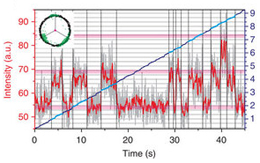Research Abstract
F1-ATPaseの制御された回転によって明らかになった、ATP合成のための特異的で連続的な結合変化
Controlled rotation of the F1-ATPase reveals differential and continuous binding changes for ATP synthesis
2012年8月28日 Nature Communications 3 : 1022 doi: 10.1038/ncomms2026

F1-ATPaseは、ATPによって駆動される回転分子モーターであり、逆方向に回転させるとATPを合成する。我々は、ATP合成の機構を解明するために、磁石を使ってモーターを任意の方向に回転させ、その際に起こる蛍光標識したADPとATPの結合と解離をイメージングした。本論文では、モーターが360度回転する際の3つの触媒部位それぞれの結合と解離の速度について報告する。このような速度は回転方向には大きく依存しないことがわかった。このことは、加水分解によって駆動される回転の直接逆転によってATP合成が起こることを示している。ADPとATPは角度によって結合に違いがあったが、解離に違いはなかった。リン酸は、ATP合成のために、ADP結合が不可欠である角度でATPの結合を阻害した。合成が行われる方向の回転では、ADPの親和性が104倍以上に上昇し、その後ATPの親和性が高くなり、最後にATPの親和性が104分の1以下に低下した。角度によるこのような変化は漸進的に起こり、これは回転角度と結合部位の親和性が緊密に共役していることを示している。
- 学習院大学 理学部物理学科
- 情報通信研究機構 未来ICT研究所
- 京都産業大学 総合生命科学部 生命システム学科
- ATP合成制御プロジェクトInternational Cooperative Research Project (ICORP)
- 早稲田大学理工学術院 先進理工学部 物理学科
F1-ATPase is an ATP-driven rotary molecular motor that synthesizes ATP when rotated in reverse. To elucidate the mechanism of ATP synthesis, we imaged binding and release of fluorescently labelled ADP and ATP while rotating the motor in either direction by magnets. Here we report the binding and release rates for each of the three catalytic sites for 360° of the rotary angle. We show that the rates do not significantly depend on the rotary direction, indicating ATP synthesis by direct reversal of the hydrolysis-driven rotation. ADP and ATP are discriminated in angle-dependent binding, but not in release. Phosphate blocks ATP binding at angles where ADP binding is essential for ATP synthesis. In synthesis rotation, the affinity for ADP increases by >104, followed by a shift to high ATP affinity, and finally the affinity for ATP decreases by >104. All these angular changes are gradual, implicating tight coupling between the rotor angle and site affinities.

